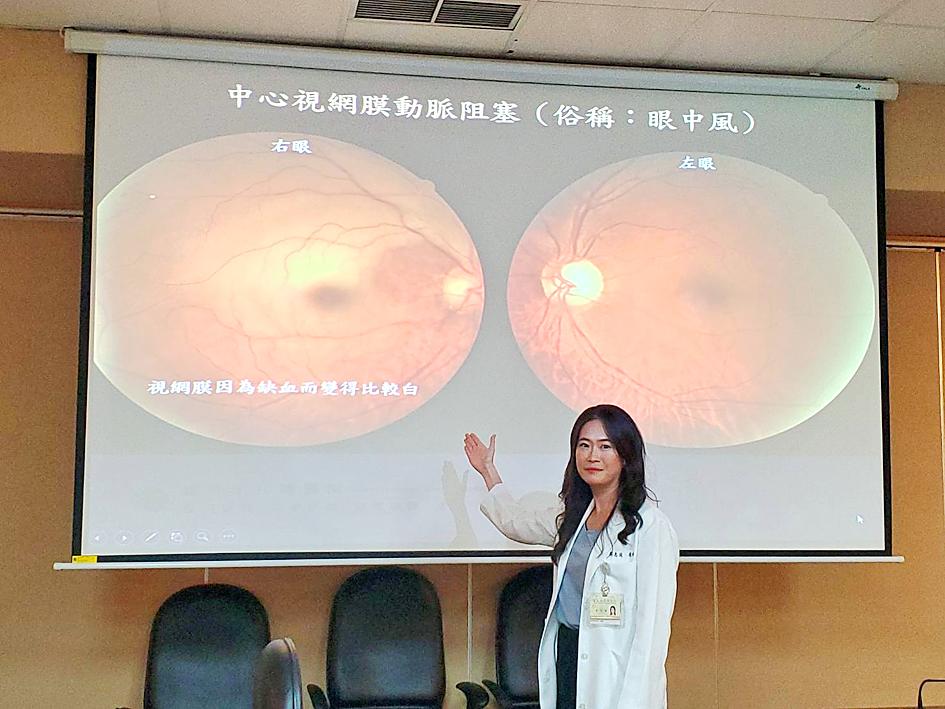Exposure to air pollution can cause a person to be 2.16 times more likely to experience eye strokes, which can cause vision loss, researchers in Taipei said yesterday.
Analyzing National Health Insurance Administration data and data from air-quality and weather sensors nationwide, a team of researchers from Taipei Veterans General Hospital, National Yang-Ming University, and Yuan Ze University found a correlation between air pollution and the occurrence of eye strokes.
An increase of air pollution over a one-week period by just one part per billion can cause those exposed to be 1.1 times more likely to experience an eye stroke, the team said.

Photo: Lin Hui-chin, Taipei Times
Diabetics, people with high blood pressure, high cholesterol or other pre-existing conditions face an even higher risk: They are 1.4 to 2.16 times as likely to have an eye stroke, the team said.
Neuro-ophthalmologist Cheng Hui-chen (鄭惠禎) said that eye strokes occur when there is insufficient blood flow to the tissues in the front part of the optic nerve, and while such strokes are sudden and painless, they can result in serious vision loss.
One patient she treated, a 67-year-old man, had lost the sight in his right eye, due to a lack of blood flow to the eye, she said.
Fortunately, using angiography, injections to dissolve blood clots in the optical arteries and hyperbaric oxygen therapy, doctors were able to largely restore the man’s vision, Cheng said.
Doctors already know about the link between air pollution and an increased risk of conjunctivitis, xerophthalmia (abnormal drying of the eye), retinal-vein occlusion and other conditions, but the research team hoped to expand upon those findings with their project, she said.
In the study, the team looked at 93 patients who had experienced eye strokes between 2001 and 2013, and compared their details with the data from 603 weather sensors and 78 air-quality sensors near the patients’ homes, she said.
The team found that an increase in air pollutants such as nitrogen dioxide, sulfur dioxide and fine particulate matter of 2.5 micrometers (PM2.5) or PM10 correlated with a significant increase in the rate of eye strokes, she said.
Air pollutants can enter the optical veins through the respiratory tract, passing from the veins in the lungs to those in the eyes through the circulatory system, and causing blockages when they reach the eyes, she said.
One way to reduce the risk of eye strokes is to reduce exposure to air pollution by using public transportation instead of riding scooters, she said.
The elderly and those with preexisting conditions should also wear masks on days when pollution levels are high, she said.

Taiwan is to commence mass production of the Tien Kung (天弓, “Sky Bow”) III, IV and V missiles by the second quarter of this year if the legislature approves the government’s NT$1.25 trillion (US$39.78 billion) special defense budget, an official said yesterday. Commenting on condition of anonymity, a defense official with knowledge of the matter said that the advanced systems are expected to provide crucial capabilities against ballistic and cruise missiles for the proposed “T-Dome,” an advanced, multi-layered air defense network. The Tien Kung III is an air defense missile with a maximum interception altitude of 35km. The Tien Kung IV and V

The disruption of 941 flights in and out of Taiwan due to China’s large-scale military exercises was no accident, but rather the result of a “quasi-blockade” used to simulate creating the air and sea routes needed for an amphibious landing, a military expert said. The disruptions occurred on Tuesday and lasted about 10 hours as China conducted live-fire drills in the Taiwan Strait. The Civil Aviation Administration (CAA) said the exercises affected 857 international flights and 84 domestic flights, affecting more than 100,000 travelers. Su Tzu-yun (蘇紫雲), a research fellow at the government-sponsored Institute for National Defense and Security Research, said the air

Taiwan lacks effective and cost-efficient armaments to intercept rockets, making the planned “T-Dome” interception system necessary, two experts said on Tuesday. The concerns were raised after China’s military fired two waves of rockets during live-fire drills around Taiwan on Tuesday, part of two-day exercises code-named “Justice Mission 2025.” The first wave involved 17 rockets launched at 9am from Pingtan in China’s Fujian Province, according to Lieutenant General Hsieh Jih-sheng (謝日升) of the Office of the Deputy Chief of the General Staff for Intelligence at the Ministry of National Defense. Those rockets landed 70 nautical miles (129.6km) northeast of Keelung without flying over Taiwan,

A strong continental cold air mass is to bring pollutants to Taiwan from tomorrow, the Ministry of Environment said today, as it issued an “orange” air quality alert for most of the country. All of Taiwan except for Hualien and Taitung counties is to be under an “orange” air quality alert tomorrow, indicating air quality that is unhealthy for sensitive groups. In China, areas from Shandong to Shanghai have been enveloped in haze since Saturday, the ministry said in a news release. Yesterday, hourly concentrations of PM2.5 in these areas ranged from 65 to 160 micrograms per cubic meter (mg/m³), and pollutants were